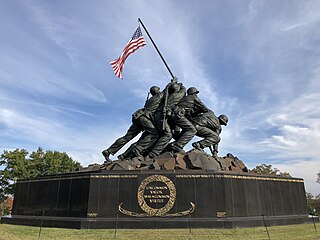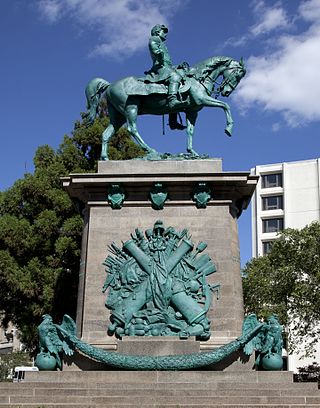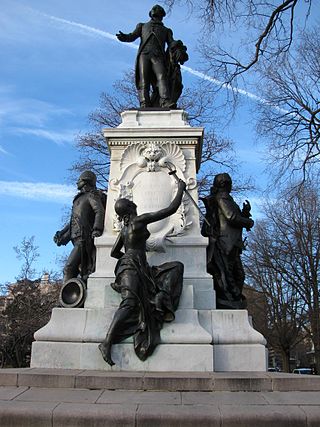
David Glasgow Farragut was a flag officer of the United States Navy during the American Civil War. He was the first rear admiral, vice admiral, and admiral in the United States Navy. He is remembered for his bold order at the Battle of Mobile Bay, usually shortened to, "Damn the torpedoes. .. full speed ahead" in U.S. Navy tradition.

The United States Marine Corps War Memorial is a national memorial located in Arlington Ridge Park in Arlington County, Virginia. The memorial was dedicated in 1954 to all Marines who have given their lives in defense of the United States since 1775. It is located in Arlington Ridge Park within the George Washington Memorial Parkway, near the Ord-Weitzel Gate to Arlington National Cemetery and the Netherlands Carillon. The memorial was turned over to the National Park Service in 1955.

Felix Weihs de Weldon was an American sculptor. His most famous pieces include the United States Marine Corps War Memorial in the Arlington National Cemetery, Virginia, US, and the Malaysian National Monument (1966) in Kuala Lumpur.

Farragut Square is a city square in Washington, D.C.'s Ward 2. It is bordered by K Street NW to the north, I Street NW to the south, on the east and west by segments of 17th Street NW, and interrupts Connecticut Avenue NW. It is the sister park of McPherson Square two blocks east. It is serviced by two stops on the Washington Metro rail system: Farragut North on the Red Line and Farragut West on the Blue, Orange, and Silver Lines.

Lavinia Ellen "Vinnie" Ream Hoxie was an American sculptor. Her most famous work is the statue of U.S. President Abraham Lincoln in the United States Capitol rotunda. Ream's Statue of Sequoyah and Statue of Samuel J. Kirkwood are both part of the National Statuary Hall collection. Other notable works by Ream include the Statue of David Farragut and the Bust of Edwin B. Hay, which are also both located in Washington, D.C. Additionally, Ream created works which were displayed at The Woman's Building at the 1893 World's Columbian Exposition in Chicago.

Lincoln Park is the largest urban park located in the Capitol Hill neighborhood of Washington, D.C. It was known historically as Lincoln Square. From 1862 to 1865, it was the site of the largest hospital in Washington, DC: Lincoln Hospital.

The Peace Monument, also known as the Navy Monument, Naval Monument or Navy-Peace Monument, stands on the western edge of the United States Capitol Complex in Washington, D.C. It is in the middle of Peace Circle, where First Street and Pennsylvania Avenue NW intersect. The surrounding area is Union Square, which the monument shares with the Ulysses S. Grant Memorial, James A. Garfield Monument, and the Capitol Reflecting Pool. The front of the monument faces west towards the National Mall while the east side faces the United States Capitol.

The John Paul Jones Memorial, also known as Commodore John Paul Jones, is a monument in West Potomac Park, Washington, D.C. The memorial honors John Paul Jones, the United States' first naval war hero, and received the Congressional Gold Medal after the American Revolutionary War ended. Jones allegedly said "I have not yet begun to fight!" during the Battle of Flamborough Head.

Major General John A. Logan, also known as the General John A. Logan Monument and Logan Circle Monument, is an equestrian statue in Washington, D.C., that honors politician and Civil War general John A. Logan. The monument is sited in the center of Logan Circle, a traffic circle and public park in the Logan Circle neighborhood. The statue was sculpted by artist Franklin Simmons, whose other prominent works include the Peace Monument and statues in the National Statuary Hall Collection. The architect of the statue base was Richard Morris Hunt, designer of prominent buildings including the Metropolitan Museum of Art in New York City and The Breakers in Newport, Rhode Island. Prominent attendees at the dedication ceremony in 1901 included President William McKinley, members of his cabinet, Senator Chauncey Depew, Senator Shelby Moore Cullom, and General Grenville M. Dodge.

General Philip Sheridan is a bronze sculpture that honors Civil War general Philip Sheridan. The monument was sculpted by Gutzon Borglum, best known for his design of Mount Rushmore. Dedicated in 1908, dignitaries in attendance at the unveiling ceremony included President Theodore Roosevelt, members of the President's cabinet, high-ranking military officers and veterans from the Civil War and Spanish–American War. The equestrian statue is located in the center of Sheridan Circle in the Sheridan-Kalorama neighborhood of Washington, D.C. The bronze statue, surrounded by a plaza and park, is one of eighteen Civil War monuments in Washington, D.C., which were collectively listed on the National Register of Historic Places in 1978. The sculpture and surrounding park are owned and maintained by the National Park Service, a federal agency of the Interior Department.

Major General George B. McClellan is an equestrian statue in Washington, D.C. that honors politician and Civil War general George B. McClellan. The monument is sited on a prominent location in the Kalorama Triangle neighborhood due to efforts made by area residents. The statue was sculpted by American artist Frederick William MacMonnies, a graduate of the École des Beaux-Arts whose best known work is a statue of Nathan Hale in New York City. MacMonnies was chosen to design the statue following a lengthy competition organized by a statue commission, led by then Secretary of War William Howard Taft. The monument was dedicated in 1907, with prominent attendees at the ceremony including President Theodore Roosevelt, New York City mayor George B. McClellan Jr., politicians, generals and thousands of military personnel.

Major General Marquis Gilbert de Lafayette is a statue in the southeast corner of Lafayette Square, in Washington, D.C., near the intersection of Pennsylvania Avenue and Madison Place, across the street from the White House. The statue was erected in 1891 to honor Gilbert du Motier, Marquis de Lafayette, and his contributions in the American Revolutionary War. The square, originally part of the President's Park, was named in honor of the Marquis in 1824 during a visit he made to the U.S. The statuary was made by Alexandre Falguière and Antonin Mercié, and the architect who designed the marble pedestal was Paul Pujol. The monument comprises a bronze statue of the Marquis de Lafayette about 11 ft (3.4 m) high, standing on a French marble pedestal with four faces decorated with classical mouldings, accompanied by seven additional bronze statues, all larger than life size.

Major General George Henry Thomas, also known as the Thomas Circle Monument, is an equestrian sculpture in Washington, D.C. that honors Civil War general George Henry Thomas. The monument is located in the center of Thomas Circle, on the border of the downtown and Logan Circle neighborhoods. It was sculpted by John Quincy Adams Ward, best known for his work on the statue of George Washington in Wall Street, Manhattan. Attendees at the dedication in 1879 included President Rutherford B. Hayes, Generals Irvin McDowell, Philip Sheridan, and William Tecumseh Sherman, senators and thousands of soldiers.

Brevet Lt. General Winfield Scott is an equestrian statue in Washington, D.C., that honors career military officer Winfield Scott. The monument stands in the center of Scott Circle, a traffic circle and small park at the convergence of 16th Street, Massachusetts Avenue and Rhode Island Avenue NW. The statue was sculpted by Henry Kirke Brown, whose best-known works include statues of George Washington in New York and Nathanael Greene in Washington, D.C. It was the first of many sculptures honoring Civil War generals that were installed in Washington, D.C.'s traffic circles and squares and was the second statue in the city to honor Scott.

The Dupont Circle Fountain, formally known as the Rear Admiral Samuel Francis Dupont Memorial Fountain, is a fountain located in the center of Dupont Circle in Washington, D.C. It honors Rear Admiral Samuel Francis Du Pont, a prominent American naval officer and member of the Du Pont family. The fountain replaced a statue of Du Pont that was installed in 1884. Designed by Henry Bacon and sculpted by Daniel Chester French, the fountain was dedicated in 1921. Prominent guests at the dedication ceremony included First Lady Florence Harding, Secretary of War John W. Weeks and Secretary of the Navy Edwin Denby.

The statue of John Aaron Rawlins, a United States Army general who served during the Civil War and later as Secretary of War, is a focal point of Rawlins Park, a small public park in Washington, D.C.'s Foggy Bottom neighborhood. It was installed in 1874, but relocated several times between 1880 and 1931. The statue was sculpted by French-American artist Joseph A. Bailly, whose best known work is the statue of George Washington in front of Independence Hall in Philadelphia.

Major General Comte Jean de Rochambeau is a bronze statue honoring Jean-Baptiste Donatien de Vimeur, comte de Rochambeau, a French nobleman and general who played a major role in helping the Thirteen Colonies win independence during the American Revolutionary War. Rochambeau joined the French military as a teenager, participating in the War of Austrian Succession, after which he was promoted to colonel, and the Seven Years' War. During the war in America, Louis XVI asked Rochambeau to lead a force of 5,500 French soldiers to assist the fight against the Kingdom of Great Britain. He and George Washington later worked together in the successful siege of Yorktown. He led the Army of the North during the French Revolutionary Wars, but was arrested and almost executed during the Reign of Terror. His military rank was restored by Napoleon and Rochambeau died a few years later in 1807.

American Revolution Statuary is a group of fourteen statues in Washington, D.C., which honor men whose actions assisted the Thirteen Colonies in their fight against the Kingdom of Great Britain in the American Revolutionary War. They are spread throughout the city, except for the four statues in Lafayette Square, across from the White House, that honor some of the foreign heroes from the war. Some of the statues are located in prominent places, while others are in small parks or stand alone in front of buildings. All of the statues are owned and maintained by the National Park Service, an agency of the United States Department of the Interior. The statuary was collectively listed on the National Register of Historic Places (NRHP) in 1978 and the District of Columbia Inventory of Historic Sites the following year. In addition, most are also contributing properties to historic districts listed on the NRHP.

Admiral David Glasgow Farragut, also known as the Admiral Farragut Monument, is an outdoor bronze statue of David Farragut by Augustus Saint-Gaudens on a stone sculptural exedra designed by the architect Stanford White, installed in Manhattan's Madison Square, in the U.S. state of New York.





















